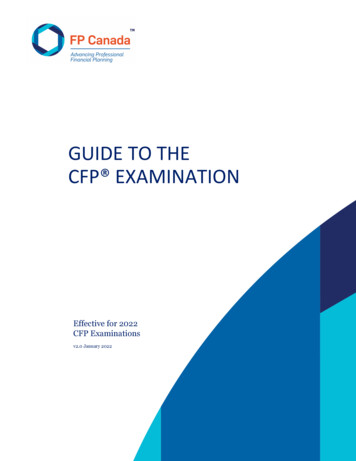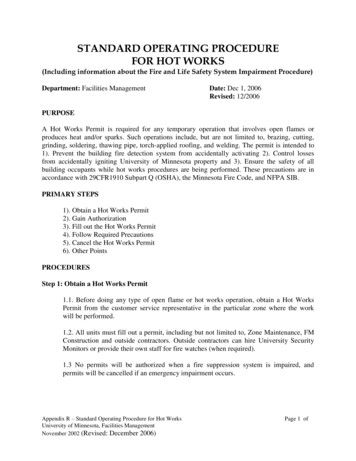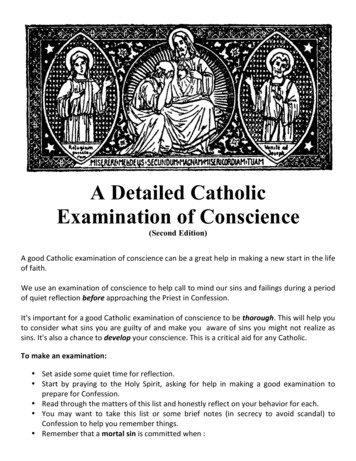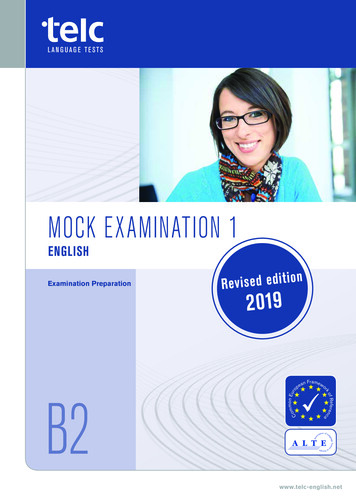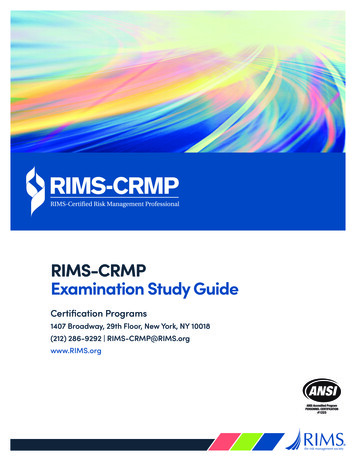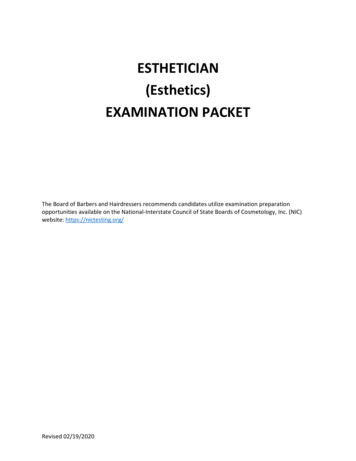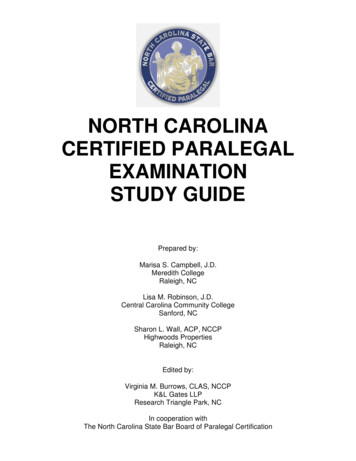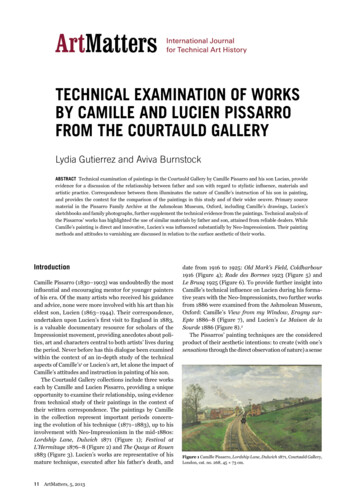
Transcription
Technical examination of worksby Camille and Lucien Pissarrofrom the Courtauld GalleryLydia Gutierrez and Aviva BurnstockAbstract Technical examination of paintings in the Courtauld Gallery by Camille Pissarro and his son Lucian, provideevidence for a discussion of the relationship between father and son with regard to stylistic influence, materials andartistic practice. Correspondence between them illuminates the nature of Camille’s instruction of his son in painting,and provides the context for the comparison of the paintings in this study and of their wider oeuvre. Primary sourcematerial in the Pissarro Family Archive at the Ashmolean Museum, Oxford, including Camille’s drawings, Lucien’ssketchbooks and family photographs, further supplement the technical evidence from the paintings. Technical analysis ofthe Pissarros’ works has highlighted the use of similar materials by father and son, attained from reliable dealers. WhileCamille’s painting is direct and innovative, Lucien’s was influenced substantially by Neo-Impressionism. Their paintingmethods and attitudes to varnishing are discussed in relation to the surface aesthetic of their works.IntroductionCamille Pissarro (1830–1903) was undoubtedly the mostinfluential and encouraging mentor for younger paintersof his era. Of the many artists who received his guidanceand advice, none were more involved with his art than hiseldest son, Lucien (1863–1944). Their correspondence,undertaken upon Lucien’s first visit to England in 1883,is a valuable documentary resource for scholars of theImpressionist movement, providing anecdotes about politics, art and characters central to both artists’ lives duringthe period. Never before has this dialogue been examinedwithin the context of an in-depth study of the technicalaspects of Camille’s1 or Lucien’s art, let alone the impact ofCamille’s attitudes and instruction in painting of his son.The Courtauld Gallery collections include three workseach by Camille and Lucien Pissarro, providing a uniqueopportunity to examine their relationship, using evidencefrom technical study of their paintings in the context oftheir written correspondence. The paintings by Camillein the collection represent important periods concerning the evolution of his technique (1871–1883), up to hisinvolvement with Neo-Impressionism in the mid-1880s:Lordship Lane, Dulwich 1871 (Figure 1); Festival atL’Hermitage 1876–8 (Figure 2) and The Quays at Rouen1883 (Figure 3). Lucien’s works are representative of hismature technique, executed after his father’s death, and11ArtMatters, 5, 2013date from 1916 to 1925: Old Mark’s Field, Coldharbour1916 (Figure 4); Rade des Bormes 1923 (Figure 5) andLe Brusq 1925 (Figure 6). To provide further insight intoCamille’s technical influence on Lucien during his formative years with the Neo-Impressionists, two further worksfrom 1886 were examined from the Ashmolean Museum,Oxford: Camille’s View from my Window, Eragny surEpte 1886–8 (Figure 7), and Lucien’s Le Maison de laSourde 1886 (Figure 8).2The Pissarros’ painting techniques are the consideredproduct of their aesthetic intentions: to create (with one’ssensations through the direct observation of nature) a senseFigure 1 Camille Pissarro, Lordship Lane, Dulwich 1871, Courtauld Gallery,London, cat. no. 268, 45 73 cm.
Ly d i a G u t i e r r e z a n d A v i v a B u r n s t o c kTechnical examination of works by Camille and Lucien PissarroFigure 2 Camille Pissarro, Festival at L’Hermitage 1876–8, CourtauldGallery, London, cat. no. 402, 45.5 55 cm.Figure 5 Lucien Pissarro, Rade des Bormes 1923, Courtauld Gallery, London,cat. no. 188, 54.5 66 cm.Figure 3 Camille Pissarro, The Quays at Rouen 1883, Courtauld GalleryLondon, cat. no. 317, 46.5 56 cm.Figure 6 Lucien Pissarro, Le Brusq 1925, Courtauld Gallery, London, cat.no. 1946, 53.5 64.5 cm.Figure 4 Lucien Pissarro, Old Mark’s Field, Coldharbour 1916, CourtauldGallery, London, cat. no. 1942, 50.5 65 cm.Figure 7 Camille Pissarro, View from my Window, Eragny sur-Epte 1886–8,Ashmolean Museum, Oxford, 65.3 81.3 cm.12ArtMatters, 5, 2013
Ly d i a G u t i e r r e z a n d A v i v a B u r n s t o c kTechnical examination of works by Camille and Lucien PissarroTable 1 Comparison of supports and grounds of works examined.Title and dateLordship Lane, Dulwich 1871Dimensionscanvas cm2H W45 73cmCamille PissarroThreadcount cm2Supplierweft warp15 15Festival at L’Hermitage1876–845.5 55cmThe Quays at Rouen 188346.5 56cm14 15View from my Window,Eragny-sur-Epte 1886–8(Ashmolean Museum)65.3 81.3cm§24 21Artist preparedCommerciallypreparedLatouche, Paris(stamp).Commerciallyprepared.Components of groundMedia1Lead white bariumsulphate chalk toningpigmentsLinseed oil P/S 1.6Lower: lead white chalk charcoal.§Upper: lead white zinc chalk barium sulphate toning pigmentsLead white bariumsulphate chalk yellow Linseed oil P/S 1.8ochre§§Lucien PissarroLe Maison de la Sourde 1886(Ashmolean Museum)Old Mark’s Field,Coldharbour 1916Rade des Bormes 1923Le Brusq 192558.5 72.5cm50.5 65cm§16 1554.5 66cm14 1453.5 64.5cm18 19Artist prepared or§§by local colourmanH.J Pursey,Lead white chalk boneLinseed oil P/S 1.8Hammersmith,blackLondon (stamp)Lead white bariumCommerciallysulphate chalk silica Linseed oil P/S 1.6preparedFrench ultramarineProteins (perhapsCommerciallyLead white bariumanimal original:preparedsulphate silicaanimal glue size)Identified using DTMS at the Netherlands Institute for Cultural Heritage (ICN).§Analysis not undertaken.of unity within the work, achieved through appropriatecompositional design, tonal values, execution and sensitivity to the subject. In this study, particular attention isgiven to the artists’ choices of materials and their manipulation towards achieving these aims. Primary source materialin the Pissarro Family Archive at the Ashmolean Museumfurther supplemented the technical evidence from thepaintings, particularly Camille’s drawings, Lucien’s sketchbooks and family photographs.3The works were examined using standard non-invasivetechniques of surface microscopy, infrared reflectography,ultraviolet light and X-radiography (except Le Maison dela Sourde). Examination of pigments on the Courtauldpaintings was achieved through sampling and surfaceexamination with a low-powered light microscope.4Pigments, the paint layer structure and their constituent materials were identified by examination of samplesprepared as cross-sections with a microscope in incidenttungsten and ultraviolet light,5 and characterisation ofinorganic materials was supplemented by analysis usingscanning electron microscopy with energy dispersive X-rayspectroscopy (SEM-EDX).6 Analysis of the organic bindingmedium used for the ground media was undertaken usingdirect temperature resolved mass spectrometry (DTMS).7Results are summarised in Tables 1 and 2.13ArtMatters, 5, 2013The Pissarros’ ideas on paintingA close reading of the correspondence between Camilleand Lucien Pissarro from 1883 until Camille’s death in1903 reveals several themes that are integral to both artists’attitudes towards artistic production, which guided theirchoices of materials and painting techniques. Lucien wasFigure 8 Camille Pissarro, Le Maison de la Sourde 1886, Ashmolean Museum,Oxford, 58.5 72.5 cm.
ArtMatters, 5, 2013@*@Portrait of Felix 1881@The Quays at Rouen 1883*La Charcutiere 1883@*@*@#@*#*##@PbCr;BaCrPbCr*PbCr;ZnCr**Rade des Bormes 1923*Le Brusq Emerald Greengreenearth* present study, # from Bomford et al. 1990, @ from Tate Gallery Conservation records for cat. nos. 5574, 5576. Pigments identified by Joyce H. Townsend using UV and VIS microscopy and EDX.*Old Mark’s Field, geChromeredyellowochre*#The Cote des Boeufs atL’Hermitage 1877#*#*Yellowochre**Festival at l’Hermitage 1876–8*#*#Ivoryblack*#The Avenue, Sydenham 1871#*Zincwhite**Lordship Lane 1871*View from my Window, Eragnysur-Epte 1886–8*Le Maison de la Sourde 1886*#LeadwhiteFox Hill, Upper Norwood 1870#Painting1Table 2 Pigments identified.Camille Pissarro14Lucien Pissarro***@@#*#*#Vermilion*Madderon Al;Madderon Ca*Madderon Al;Ca*@@Madderon AlMadderon Sn;Ca# on Al;Ca; SnOn Sn;StarchRed lakeLy d i a G u t i e r r e z a n d A v i v a B u r n s t o c kTechnical examination of works by Camille and Lucien Pissarro
Ly d i a G u t i e r r e z a n d A v i v a B u r n s t o c kTechnical examination of works by Camille and Lucien PissarroFigure 9 Lower left corner of Camille’s The Quays at Rouen showing pinholesthat were used to separate wet paintings in transit.highly receptive to his father’s opinions in all matters, andeach artist sought to materialise in his own paintings anoverall aesthetic unity,8 achieved through an acute understanding of compositional design learnt through the directemulation of nature and old masters; tonal values basedon an understanding of current scientific theory; and theevolution of a style of execution appropriate to one’s temperament, subject and vision. There is a pervading senseof Camille’s fearfulness for his son’s career through theirassociation, evidenced in Camille’s letter to Lucien, 1893:Although we have substantially the same ideas, theseare modified in you by youth and a milieu strange tome; and I am thankful for that; what I fear most isfor you to resemble me too much.9Thus the impetus for Lucien to develop his own ‘note’10 distinct from Camille’s, while being based on shared concepts,is particularly apparent in both artists’ minds.11 Lucien’scorrespondence with his wife Esther after Camille’s deathoccasionally reflects this concern, referring to his own ‘personality [as a] weak diminution of the poor dear old father’ and‘my pictures are at best only a weak duplicate of the father’s’.What Camille found vital in all art, whether of the greatmasters in the Louvre, or the artisans who carved the Gothicdoorways of Rouen, was ‘la sensation’, the feeling roused bysome immediate observation of the world around us, andthe ability to pass it on.12 Camille insisted that his sensationswere the essential basis of his art, and instilled this in Lucien:give free play to your sensations your problem isto discover an execution appropriate to your spirit Do not overdevelop a critical sense, and trust yoursensations blindly.13For the Pissarros, the realisation of one’s sensation in paintwas the ultimate aim of the Impressionist artist workingin the open air, which when combined with an executionunique and appropriate to the individual artist, produceda unified image.1415ArtMatters, 5, 2013Plein air painting, popularised by Camille and theImpressionists, was the prime means of accessing la sensation, which Camille proclaimed was the basis of his art.Camille had a ‘rolling studio’ built by a local carpenter,a two-wheeled cart mounted with a large box containingeasels, brushes, pigments and canvases. Lucien followedthis practice, painting in the open air before his motif toarouse sensation, as is seen in photographs from the 1930s.Physical evidence for this is found on Camille’s The Quaysat Rouen as canvas pins in the corners for separating wetpaintings in transit (Figure 9) and in Lucien’s paintings,where organic debris lies embedded in the paint layers onthe outer edges.Camille acknowledged to Lucien in 1887 the importance of contemporary nineteenth-century colour theoryto their art:But surely it is clear that we could not pursue ourstudies of light with much assurance if we did nothave as a guide the discoveries of Chevreul and otherscientists. I would not have distinguished betweenlocal colour and light if science had not given us thehint; the same holds true for complementary colours,contrasting colours, etc.15Lucien’s debut as a painter occurred in the mid-1880sduring a period when Camille was struggling to realise hisaesthetic regarding colour values and execution in producing a unified image, and together with Lucien adopted themethod of pure tone division being developed by Seurat andSignac. Camille’s association with the Neo-Impressionistswas brief, from which he emerged ‘with a difference: hekept his colours purer, and got a more scientific kind ofdivision’.16 He adapted tone division to suit his temperament, as the painstaking pointillist predetermination ofhues and method that involved allowing each brushstroketo dry before applying another stifled what drove Camilleas an artist, his sensation. Lucien remained an advocateof Neo-Impressionist tone division throughout his painting career, he judiciously copied Seurat’s disc, constructedaccording to Chevreul’s and Rood’s principles,17 and alsorecorded the various principles that guided Seurat andhis friends in the application of the disc to their work.18The laws of simultaneous contrast are applied in modifiedform in Lucien’s paintings, predominantly based on complementary relationships between green / red-purple andblue / orange. From early on, Lucien mixed a high proportion of white into his hues, so that the ‘discord’ betweenthe hues was lessened, resulting in the distinctive matt‘blondness’ that characterises his work and differs fromthe ‘violent purity of tints which hurts the eye’19 aimed atby the Neo-Impressionists.The striving for overall aesthetic unity in their workguided the Pissarros’ choices of materials and techniqueswhereby all elements could be combined and realised harmoniously on the paint surface. Lucien modified his lessonsfrom Camille into his own style or ‘vision’, and as a resulthis works are technically distinct from his father’s.
Ly d i a G u t i e r r e z a n d A v i v a B u r n s t o c kTechnical examination of works by Camille and Lucien PissarroThe Pissarros’ materialsPrimingCanvasesThe Pissarros generally preferred whitish, smooth double-primed supports, the priming thoroughly filling thecanvas weave in most of the works examined. The colourof the ground plays a fundamental role and both artistsexploited this as a unifying tone that modifies throughsimultaneous contrast each hue rendered upon it. Most ofCamille’s grounds are off white, although he experimentedusing coloured priming. He mixes coloured pigments intohis priming for Lordship Lane,26 producing a pale creamytone, intended to render his paint layers more brilliant.The pinkish priming on The Quays at Rouen has dictatedCamille’s colour scheme, as the complementary pigmentemerald green predominates throughout the paint mixtures.Lucien’s primings are consistently white according to NeoImpressionist aesthetic, now somewhat darkened throughdiscoloration of the components and lining treatments.27The saturating varnish coatings on Camille’s works in theCourtauld further lend to a disrupted impression of theoriginally sought aesthetic.28Both painters sought an effect of surface mattness androughness, attained by using semi-absorbent grounds thatwould ‘wick’ away medium from the paint and promoterapid drying, helping to produce porous, rough paint surfaces which scatter light.29 Le Maison de la Sourde exhibitsan extremely chalky and brittle ground, so leanly bound andpoorly adhered to the support that the fine craquelure interpenetrates throughout the paint layers. The fragile cohesionadhesion of the ground also found in Lordship Lane, TheQuays at Rouen and Rade des Bormes, reinforces a preference for leanly bound semi-absorbent priming materials.Both Camille’s and Lucien’s grounds are bound leanlyin linseed oil,30 however Lucien’s Le Brusq included ananimal glue (Table 1). EDX analysis shows lead white asthe principal component for their grounds, with calciumcarbonate (natural chalk), barium sulphate or calciumsulphate occasionally present as extenders and additionalcoloured pigments to provide tone.31 In Rade des Bormesand Le Brusq, EDX analysis identified elements consistent with the presence of barium sulphate, chalk and silica,with the lead white, and a small amount of zinc, that maybe indicative of the addition of lithopone. The large particlesize of the extenders creates texture and has a glisteningeffect, further enhancing the light-scattering matt effects ofa rough surface (Figure 10). Darkening of the appearance ofthe ground, caused by retention of dirt and aged coatingsin the fine cracking of the surface has changed the originally intended effect, especially in Rade des Bormes.32 Theparticular absorbency of grounds that contain glue bindingmedia is demonstrated here.33A phenomenon identified on several works is the intentional abrasion of the priming exposing the canvas indicatedby drawing, underpainting and paint layers running acrossthe exposed weave. The abrasion is localised across the skyin Lordship Lane and Le Brusq, and in The Quays at Rouenit is confined to a horizontal strip across the centre, corresponding to the orientation of the river (Figure 11). ExposingFrom the works examined, the Pissarros displayed a preference for commercially prepared plain weave fine linencanvases of standard formats, bought from various suppliersthroughout their lifetimes20 (Table 1). Camille preferentiallyordered canvases from the artists’ colourman Latouche,21whose stamp appears on Quays at Rouen, Contet,22 andJulian Pere Tanguy. In France, Lucien bought his canvases from his father’s supplier Contet, and in Englandhe may have occasionally have bought from Roberson& Co, Percy Young23 and H.J. Pursey of Hammersmith,whose stamp appears on Old Mark’s Field, Coldharbour.Camille’s Lordship Lane and perhaps Lucien’s La Maisonde la Sourde are artist-prepared supports, and while bothare standard format, indicating off-the-shelf stretchers,the canvas is attached haphazardly with nails through thebare threads around the tacking edges.24 Camille’s requestto Lucien in 1887 for Contet to send a prepared canvas to fitan existing stretcher or strainer reaffirms this practice, aswell as his close relationship with Contet and preference forthe quality of his wares.25Figure 10 Cross-section from Lucien’s Rade de Bormes showing coarseparticles of barium sulphate in the ground.Figure 11 Detail of a typical abraded canvas used for Camille’s The Quaysat Rouen.16ArtMatters, 5, 2013
Ly d i a G u t i e r r e z a n d A v i v a B u r n s t o c kTechnical examination of works by Camille and Lucien Pissarrothe pale weave originally would have enhanced the lighttone of those areas, particularly desirable for emulating, forinstance, the reflection of light across water or the diffusionof light within the sky’s atmosphere. This intended aesthetichas now altered significantly due to degradation of the canvas and accumulation surface material perhaps from formertreatments, rendering these passages dark.Drawing and underpaintingCamille and Lucien recorded the world around them bymaking numerous drawings in sketchbooks throughouttheir careers, emphasising the importance of drawing aspart of the preparation for painting. For Camille, drawingswere done as a means of establishing compositional formula or studying independent figures and objects, forming avisual library for future reference, but no direct preparatorydrawings have been identified for his Courtauld paintings.This lends credence to the notion that drawings were intentionally made for structuring the pictorial surface34 beforesensation was realised in paint.Lucien’s sketchbooks record his surroundings and compositional drawings, however unlike Camille, many of thesedid evolve into paintings. Compositional drawings directlyrelating to Old Mark’s Field, Rade des Bormes and Le Brusqare accompanied with several variants of the same view,which are summarised in the underdrawing stage for hispaintings. Both artists’ preference for charcoal sketchingmedia is reflected in their underdrawing, visible in TheQuays at Rouen and all of Lucien’s works studied.Camille employs a calligraphic type of brushwork forhis underpainting in Lordship Lane, using charcoal in afluid, probably oil-based medium, diluted with turpentine. The lines applied with a thin brush describe thegeneral composition and features of the landscapes, andare intentionally exposed beneath the paint layers, reinforcing contours. This evolves into a dark blue line onCamille’s paintings from the early 1870s, similar to thetechnique used by Paul Cezanne,35 not consistently appliedas a preliminary stage (Figure12). Lucien clearly emulateshis father’s working practice, although his preliminarystages of underdrawing and sketched blue underpaintingare formulaic. Lucien first sketches out his compositionusing charcoal or conté crayon, and then reinforces andelaborates upon the lines with French ultramarine in afluid medium, applied with a thin brush (Figure 13).36 Theline denotes contour and is consistently exposed betweenthe blocking in of pale impasted paint layers for different forms, thus lending three-dimensionality through itsdarker tone and physical presence as a flat layer upon theground. This contrasts with Camille’s overworking of hislines in Lordship Lane and View from my Window, andalthough both artists tend to reinforce the lines in theirupper paint layers, Lucien’s underpainting plays a significant role in the final aesthetic of his image, in which thelines fulfil an autonomous, unadulterated role.17ArtMatters, 5, 2013PigmentsIn the 1880s, Camille asked Contet, his chief supplier ofpaints, to prepare colours, probably to order, ‘on a base ofzinc’, presumably zinc white.37 This would have resulted inincreased opacity and mattness for his paints, and analysisof samples confirms the continuous use of zinc combinedwith lead white as a manufactured mixture (Table 2).In 1877–9, Camille composed a landscape on his palette from six hues, demonstrating his method of peintureclaire,38 intended to give a unifying harmony to a work bymixing hues from a limited palette of ‘spectral’ colours.Georges Lecomte in 1890 stressed Camille’s achievementof a peinture blonde:Since 1865, the painter has initially expurged hispallet of black, this ‘non’ colour; a little later theochres and the brown ones were proscribed: he doesnot paint any more but with the six colours of therainbow.39Technical analysis in this study however has identified calcium phosphate (bone or ivory black) and carbon blackpigments in Camille’s paintings from 1870 and 187140 (TableFigure 12 Camille’s use of underdrawing and a charcoal and blue paintedline from The Quays at Rouen.Figure 13 Detail from Lucien’s Rade de Bormes showing his underdrawing incharcoal or conté crayon, followed by French ultramarine in a fluid medium.
Ly d i a G u t i e r r e z a n d A v i v a B u r n s t o c kTechnical examination of works by Camille and Lucien PissarroFigure 14 Cross-section from the sky of Camille’s The Quays at Rouenincluding a red lake cast onto a combined tin and calcium substrate andassociated with starch that exhibits fading.Figure 15 Surface bubbles in Lucien’s impasto from Rade de Bormes due towater evaporation from pigment pre-ground in an aqueous medium beforemixing with an oil binding medium.2). Consistent with Camille’s development towards peintureclair, in Lordship Lane the colour is modified by other pigments, and is exploited as a colour in its own right for fencesand features of the landscape as well as a toning pigment,lending overcast greyness to the skies. After this period,black (charcoal) seems to be restricted to underdrawing inboth Camille’s and Lucien’s paintings. Fairly bright greenearth, red, yellow and orange iron oxide pigments are usedin Camille’s works up to the 1880s, combined with highkeyed pigments in complex mixtures. Their use then ceases,and as such no earth pigments appear to have been usedintentionally by Lucien; the yellow ochre present for thegreen-yellow mixture in Le Brusq is probably a manufacturer’s addition.41Chrome yellow is used predominantly by Camille,although the more expensive cadmium yellow featuresintermittently. Lucien’s paintings reflect this trend, and18ArtMatters, 5, 2013cadmium yellow is preferred in later years.42 In addition,Lucien used a mixed orange (chrome yellow and vermilion)and a yellow composed of lead / barium or zinc chromate,and no deterioration phenomenon was noted for chromatepigments.Vermilion features strongly in Camille’s and Lucien’spalettes. Camille exploits the intense brilliance both inmixtures and unblended on the central roof of Festivalat L’Hermitage against the emerald green underlayer.Lucien’s use of the pigment is more timid: it appears consistently in mixtures with white and yellows to producebright pinks, oranges and purples. In common with theother Impressionists, the Pissarros used red lake pigmentsfor their colour intensity, and up to three types of red lakeappear on Camille’s palette, two on Lucien’s. A red lake castonto a combined tin and calcium substrate and associatedwith starch was identified in Camille’s works examined,which exhibits fading (Figure 14). The pigment resemblesthe carmine-type lake used by Renoir from 1868 to 1919,and similar starch-containing red lake paints have beenidentified in paintings by Van Gogh, Monet and Seurat.43The intense orange fluorescence in UV light of a second lakepigment in The Quays at Rouen suggests natural madder(laque de garance), which may contain bromine in its substrate. UV- fluorescent madder lakes on alumina substrateshave been identified on the later Tate and National Galleryworks, perhaps showing Camille’s developing preferencefor the more stable madder extracts. Lucien consistentlyuses a lake based on an alumina substrate, which has a marbled orange-pink fluorescence in UV light, characteristicssimilar to madder lakes used by Renoir.44 Bright orangeUV fluorescence on the unvarnished paintings’ surfacesshows Lucien’s extensive and preferred use of this lakepigment, used pure or mixed with French ultramarine tomake purple.Camille and Lucien seem to have preferred the cheaperFrench ultramarine pigment, although cobalt blue isfound in Camille’s earlier works. In The Quays at Rouen,starch grains associated with French ultramarine wereprobably included as an extender and drier.45 Starch hasbeen identified on Impressionist paintings associatedwith poorly drying red lake, bone black or viridian pigments, probably as a manufacturer’s addition to enhancedrying properties.46 Starch paste was mixed with oil paintsduring the nineteenth century, and starch derived frompotatoes ‘prepared by the laundress’ could be bluish dueto staining with smalt prior to drying,47 consistent withthe blue coloration of the grains seen here. The watersensitivity of the French ultramarine oil paint for the central foliage in Rade des Bormes is most evident where itis used unmixed; elsewhere in the painting and in otherworks examined the pigment is combined with whiteand other pigments, rendering it less sensitive to aqueous solvents.48 Sensitivity to protic solvents is indicatedin passages of paint containing cadmium yellow. SEMimages of the surface of paint containing cadmium yellow from Le Brusq showed the characteristic rod-shapedparticles of hygroscopic magnesium sulphate hydrate
Ly d i a G u t i e r r e z a n d A v i v a B u r n s t o c kTechnical examination of works by Camille and Lucien PissarroabFigure 16 (a) Detail of the surface and (b) corresponding X-radiograph from Camille’s View from my Window, Eragny sur-Epte showing the closecorrespondence between the drawing and the painting.associated with water sensitivity in modern artists’ paintscontaining the pigment.49Emerald green and viridian were used by Camille upuntil the 1880s, after which he seems to have preferredemerald green alone. This preference is reflected in Lucien’spalette, which solely features emerald green. Camille usesboth pigments combined during the 1870s, and it is not clearwhether these are deliberate mixings or a manufacturedvert emeraude tube paint adulterated with the cheaperemerald green pigment.50 Both viridian and emerald greenpigments have proved very stable in the works examined.Probably the most important pigments used by Camilleand Lucien were white pigments, the high ratio of the pigment to other colours in mixtures being significant for thephysical and optical properties of the paint. Camille’s preference for using a mixture of lead and zinc white and forcolours mixed with zinc white is evidenced in his correspondence,51 and technical analysis confirms his consistentuse of a zinc and lead white manufactured paint. The moreneutral tone of zinc white enabled its use as a commercialextender for paints, and a generous addition of this whitematerial was found with light emerald green in The Avenueat Sydenham.52 The incorporation of the mixed white withall the pigments in the Courtauld works makes it difficultto ascertain whether zinc oxide pigment is used or whetherzinc is present as the sulphide present as lithopone addedby the manufacturer as an extender. Lucien seems to havepreferred blanc d’argent,53 and technical analysis confirmsthat lead white is predominant in his Courtauld works,however trace amounts of zinc occur indicating adulteration by the manufacturer.54Examination of Camille’s Artists Palette with aLandscape, suggests that he mixed his colours on the palette. Exceptionally, cobalt violet may be present on Viewfrom my Window, but generally he and his father preferredthe more intense purple obtained by mixing French ultramarine, red lake and vermilion with lead white. Lucienemployed a palette similar to Camille’s post-1880 palette,and the fact that most of the paintings by Lucien examinedin this study date post-1900 and are English accounts for19ArtMatters, 5, 2013observed differences in the technology of the paint (e.g. thefineness of grinding and choice of extender).It is probable that the Pissarros blotted their paints dueto their lean appearance. Lucien’s paintings demonstratethe gradua
paintings, particularly Camille's drawings, Lucien's sketch-books and family photographs.3 The works were examined using standard non-invasive techniques of surface microscopy, infrared reflectography, ultraviolet light and X-radiography (except Le Maison de la Sourde). Examination of pigments on the Courtauld

